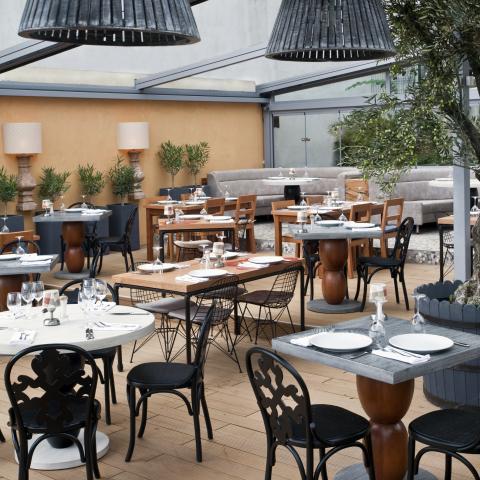
The Philippines has so many good restaurants. And when we say that, we mean that traditional Filipino food is not only unparalleled in taste and quality but that there are many places to eat in the country that let you experience authentic Filipino cuisine. For a foreigner visiting the Philippines, the overall quality of your experience eating at a Filipino restaurant is determined not only by the quality of the restaurant itself but also by how well you are familiar with Filipino restaurant phrases.
Knowing how to book a restaurant, compliment a staff, or order food in Filipino may not be vital but can significantly improve your overall experience dining at a Filipino restaurant. For that reason, we made this guide just for you. Here, you will learn how to make a reservation at your favorite restaurant in the Philippines, converse with the waiter, ask for the bill, give a tip, and much more!

The Philippines has so many good restaurants.
 Table of Contents
Table of Contents
- Making Dining Plans
- Time to Dine
- After Dining
- Tipping Etiquette
- Learn More Than Just Filipino Restaurant Phrases with FilipinoPod101!
1. Making Dining Plans
Depending on which restaurant you plan to visit, you may have to make reservations in advance. The best restaurants in big cities like Manila are usually full, so you’d want to find out first which days there aren’t a lot of customers. A simple check on Google will show you the opening hours and popular times of a restaurant you’re considering. For instance, the award-winning Spiral restaurant at Sofitel Philippine Plaza, known for its Filipino international dining, is usually busy on Saturdays during lunch, among other times.
For regular restaurants, a reservation is usually not necessary. However, it’s not unusual to find yourself in long queues occasionally, especially during the weekends.
Booking a restaurant in the Philippines isn’t that complicated. Thanks to the Internet, you can now find all the information you need about the restaurant of your choice online. Most restaurants have a social media page where you will find details on how to make a booking.
The following are some useful phrases you can use whenever you want to make a reservation at a Filipino restaurant, plus questions you can ask to get more information about the restaurant.
| Gusto ko po sanang magpareserba para sa tatlong tao. | “I’d like to make a reservation for three people.” |
| Posible bang ipareserba ang buong restawran? | “Is it possible to book the whole restaurant?” |
| Magpapareserba sana ako para mamayang gabi. | “I’d like to make a reservation for this evening.” |
| Para sa darating na Biyernes. | “For this coming Friday.” |
| Sa ika-sampu ng Enero, alas siyete ng gabi. | “On January 10th, at 7 in the evening.” |
| Bukas ba kayo ng Linggo? | “Are you open on Sunday?” |
| Anong oras kayo nagbubukas? | “What time do you open?” |
| Hanggang anong oras kayo? | “Until what time are you open?” |
| Pwede ba ang mga bata? | “Are children welcome?” |
| Lima kami, kasali na ang isang bata. | “There are five of us, including one child.” |
| Kung maaari ay yung malapit sa bintana. | “If possible, a table near the window, please.” |
| May mga mesa ba kayo sa labas? | “Do you have some tables outdoors?” |
| Marami bang kumakain kapag Sabado? | “Is it usually full on Saturdays?” |
| May parking ba para sa PWD? | “Do you have parking spaces for PWDs?” |
| May daanan ba para sa wheelchair? | “Do you have wheelchair access?” |

Posible bang ipareserba ang buong restawran? (“Is it possible to book the whole restaurant?”)
- ➜ You don’t want to approach your first Filipino restaurant experience empty-handed. Learn how to choose menu items in Filipino even before you pick up that phone to make a reservation!
2. Time to Dine
Restaurant culture in the Philippines is the same as in any culture in the world. There will be waiters and waitresses to take your order and assist you. Depending on the restaurant, there may also be complimentary drinks and appetizers. But regardless of where you choose to dine, your entire dining experience will start with you asking for the menu.
Do you need to be familiar with Filipino food vocabulary? Not necessarily, although it’s going to help. We have a couple of lessons here and here that will help you become more familiar with words and phrases related to food.
1- Before Placing Your Order
You can get the waiter’s attention simply by saying “Weyter,” which means “waiter” in Filipino. And if the one serving you is a female, you can simply address her as “Miss.” You can then follow that up by using any of the following phrases:
| Pwede ko bang makita ang menu? | “Can I see the menu?” |
| Gusto ko pong makita ang menu. | “I would like to see the menu.” |
| Pakiabot po ng menu. | “Please give us the menu.” |
| Patingin po ng menu. | “Please show us the menu.” |
| Ano ang specialty niyo dito? | “What’s your specialty in this restaurant?” |
| Ano ang pinakasikat niyong pagkain dito? | “What’s your most popular dish?” |
| Anong mairerekumenda mo? | “What would you recommend?” |
| Mairerekumenda mo ba ito? | “Would you recommend this?” |

- ➜ If you’re eating as a walk-in guest, restaurant staff may ask you a couple of questions, like how many of you are there and where you may like to be seated. Be sure to take this lesson on how to get a seat in a restaurant so you’ll know how to respond with no hesitations.
2- When You’re Ready to Order
So, you’re ready to order. If that’s the case, you will need to learn the following expressions so you’ll know what to say to the staff assisting you when it’s time for you to place your order.
| Handa na kaming umorder. | “We’re ready to order.” |
| U-order na kami. | “We are ordering now.” |
| Pakikuha ng order namin. | “Please take our order.” |
| Bigyan mo kami nito. | “Please give us this one.” |
| Gusto ko nito. | “I’d like to have this one.” |
| Dalawa nito. | “Two of these.” |
| Isang basong tubig. | “A glass of water.” |
| May kasama bang inumin ito? | “Are drinks included?” |
| May karne ba ito ng baboy? | “Does this one have pork in it?” |
| Pwede mo bang ulitin ang order namin? | “Can you please repeat our order?” |
| Gaano po katagal namin kailangang maghintay sa pagkain? | “How long do we have to wait for the food?” |
| Ikaw? Anong gusto mo? | “How about you? What do you want?” |
- ➜ “Can I see the menu?” Our lesson on how to order at a restaurant breaks down this common expression so that you understand what each word means in Filipino. Plus, get to learn other alternatives you can use.
3- Making Special Requests
There are times when you need to make special requests when eating at a restaurant. Perhaps you need to ask for more wine. Maybe you want more than just some good, basic Filipino food. Or maybe you want to let the staff know you’re allergic to certain ingredients. Whatever it is, here are expressions you can use to convey your intentions.
| Pwedeng magpadagdag ng ____? | “Could I get another ___?” |
| Pakibigyan kami ng isa pang pares ng kutsara at tinidor. | “Please give us another pair of spoons and forks.” |
| Pakidagdagan ang table napkin. | “Please add more table napkins.” |
| Bawal ako sa hipon. | “I am allergic to shrimp.” |
| Kaunting bawang lang kung maaari. | “Not a lot of garlic, please.” |
| Gusto kong palitan ito ng _____. | “I would like to replace this one with _____.” |
| Pwede ko bang palitan ito ng _____? | “Can I replace this one with _____?” |
| Pakipalitan ito ng ______. | “Please replace this one with _____.” |
| Gusto ko pa ng wine kung maaari. | “I would love some more wine, please.” |
| Pwede mo ba kaming malipat sa ibang mesa? | “Can you move us to another table?” |
4- Time for Dessert!
A visit to a good Filipino restaurant is not complete without dessert. Here’s what a simple conversation may look like between you and the staff when they ask you if you’d like to have some.
| A: Natuwa po ba kayo sa pagkain? (“Did you enjoy your meal?”) B: Oo, natuwa kami nang husto. (“Yes, we enjoyed it a lot.”) A: Gusto niyo po ba ng panghimagas? (“Would you like some dessert?”) B: Sige, anong meron? (“Sure, what have you got.”) A: Mayroon kaming halo-halo, minatamis na saging, ube halaya, at maja blanca. (“We have halo-halo, sweetened banana, ube halaya, and maja blanca.”) B: Ano yung minatamis na saging? (“What’s minatamis na saging?”) A: Saging na saba na nilagyan ng arnibal at maskubadong asukal. (“It’s Saba banana with syrup and muscovado sugar.”) B: Sige, bigyan mo kami niyan. Salamat! (“Okay, please give us that one. Thanks!”) |
5- Making Complaints and Giving Compliments
No restaurant is perfect, and every once in a while, you may find it necessary to voice out your concern regarding food or service quality. At the same time, it’s important to offer a compliment whenever it’s appropriate.
| Medyo maalat ang sabaw. | “The soup is a bit salty.” |
| Kulang sa lasa ang paella. | “The paella lacks flavor.” |
| Masyadong matamis. | “It’s too sweet.” |
| Medyo matabang. | “It’s a bit bland.” |
| Tamang-tama ang timpla ng luto niyo. | “The flavor is perfect.” |
| Sobrang sarap ng mga pagkain dito. | “The food here is so delicious!” |
| Siguradong kakain ulit ako dito! | “I’ll be eating here again for sure!” |
| Salamat sa pag-asista sa amin ngayong gabi. | “Thank you for assisting us this evening.” |
- ➜ Learning how to make complaints in Filipino is crucial as it will teach you the right words to use and the right tone and approach when voicing out your concern. And yes, we have a lesson for that!

Gusto ko nito. (“I’d like to have this one.”)
3. After Dining
You’re done with your meal, and you’re ready to leave. You can either go directly to the cashier to pay for your food or call the waiter’s attention to have your bill delivered to your table. Use the following phrases to let the staff know that you’re ready to pay for your food.
| Magbabayad na kami. | “We are going to pay now.” |
| Pakibigay na lang ng bill namin. | “Our bill, please.” |
| Handa na kaming magbayad. | “We are ready to pay.” |
| Pakibalot ng isang ito. | “Can I have a to-go box for this one, please?” Lit. “Please wrap this up.” |
| Tumatanggap ba kayo ng card? | “Do you accept card payments?” |
| Hahatiin namin ang bayad. | “We’re going to split the bill.” |
- ➜ Want to share your dining experience at a Filipino restaurant online? Before you do that, be sure to take our lesson first on must-know social media phrases about having dinner with friends!
4. Tipping Etiquette
The Philippines has a non-tipping culture, so you don’t have to oblige yourself to give a tip. However, it doesn’t necessarily mean you won’t be appreciated if you did. Feel free to leave a tip if you feel that the food and the service were excellent. In the same manner, don’t feel pressured to leave any tips if you feel that you don’t have to. Just keep in mind that some restaurants may have a no-tipping policy. To be sure, you can use the following phrases to ask whether tipping is allowed or express your intention to leave a tip.
| Tumatanggap ba kayo ng tip? | “Do you accept tips?” |
| Saan pwedeng magbigay ng tip? | “Where do I leave a tip?” |
| Gusto ko sanang magbigay ng tip. | “I would like to leave a tip.” |
| Nag-iwan ako ng tip para sa iyo. | “I left a tip for you.” |

Tumatanggap ba kayo ng tip? (“Do you accept tips?”)
- ➜ Asking for the check in Filipino isn’t as simple as it sounds. It’s a good thing we have a lesson to help you learn all the necessary words and expressions for perfecting this simple request.
5. Learn More Than Just Filipino Restaurant Phrases with FilipinoPod101!
Being able to speak Tagalog and know common restaurant phrases in Filipino will make life easier for you when you’re eating at a Filipino restaurant. In this guide, you’ve learned some of the most useful Filipino expressions to use when making reservations, ordering food, and tipping at a restaurant. Are there other words and phrases you wish we have included on this list? Let us know in the comments section.
If you love this guide, consider signing up for a free lifetime account at FilipinoPod101 where you can learn more than just Tagalog restaurant phrases. Here, you can learn and master everything about the Filipino language, including grammar, pronunciation, sentence structure, and of course, Filipino culture. Plus, you’ll learn how to use Tagalog in various scenarios in daily life. And did we mention that you can enjoy studying all this in a fun and innovative way?
Speaking of innovation, what will make your experience with FilipinoPod101 even more exciting is the MyTeacher feature, a Premium service that lets you learn Filipino at your own pace and with the guidance of an actual Filipino teacher. So, what are you waiting for? Join FilipinoPod101 today and start speaking Filipino like a local!









